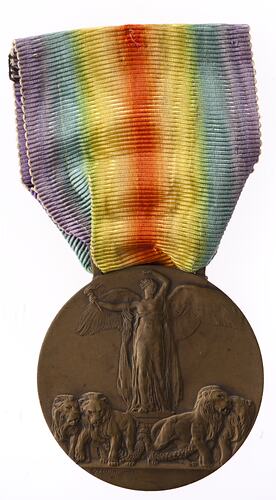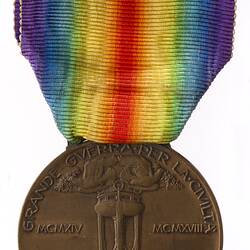Summary
Victory Medal 1914-1918, unnamed as issued, in Italy, 1918.
At the end of World War I the Allies resolved that, if they wished to issue a Victory Medal (only China and Montenegro did not), it would share a common feature of a depiction of Victory on the obverse and a ribbon of red, yellow, green, blue and violet merged into a rainbow pattern - both combining all national colours and symbolising the end of conflict).
The other Allied countries that issued Victory medals were: Belgium, Brazil, Cuba, Czechoslovakia, France, Great Britain, Greece, Japan, Portugal, Romania, Thailand, Union of South Africa and the United States of America.
Obverse Description
Figure of Victory standing facing on chariot drawn by four lions, with wings and arms spread, in her right hand she holds a torch, her left is drawn back over her head, she is looking to the right. The artist's name, G Orsolini MOD in small incuse letters in the left exergue.
Reverse Description
An ancient victory tripod with two doves flying from the top, each carrying a branch with leaves; at sides of tripod, MDCCCXIV MDCCCXVIII; around above, GRANDE . GVERRA . PER . LA . CIVLITA'; in exergue, AI COMBATTENTI DELLA NAZIONI ALLEATE ED ASSOCIATE (Translation - To the combattants of the allied and associated countries)
Edge Description
Plain
More Information
-
Collecting Areas
-
Acquisition Information
Transfer from National Gallery of Victoria (NGV), 15 Mar 1976
-
Date Issued
1918 AD
-
Issued By
-
Inscriptions
G Orsolini MOD MDCCCXIV MDCCCXVIII GRANDE . GVERRA . PER . LA . CIVLITA' AI COMBATTENTI DELLA NAZIONI ALLEATE ED ASSOCIATE
-
Material
Bronze
-
Axis
12
-
Classification
-
Category
-
Discipline
-
Type of item
-
Overall Dimensions
35 mm (Outside Diameter)
-
Shape
Round with loop and ribbon
-
References
References: [Link 1]
-
Keywords


